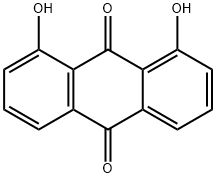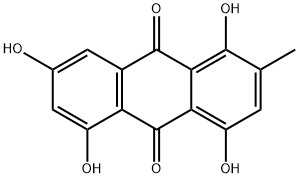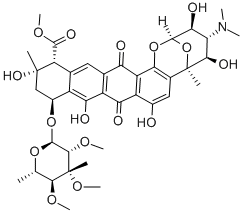1,8-Dihydroxyanthraquinone , 10mMinDMSO , 117-10-2
Synonym(s):
1,8-Dihydroxyanthraquinone;Chrysazin, Dantron;Chrysazine;Danthron
CAS NO.:117-10-2
Empirical Formula: C14H8O4
Molecular Weight: 240.21
MDL number: MFCD00001211
EINECS: 204-173-5
| Pack Size | Price | Stock | Quantity |
| 1ml | RMB159.20 | In Stock |
|
| others | Enquire |
PRODUCT Properties
| Melting point: | 191-193 °C (lit.) |
| Boiling point: | 342.92°C (rough estimate) |
| Density | 1.3032 (rough estimate) |
| bulk density | 600kg/m3 |
| refractive index | 1.5430 (estimate) |
| Flash point: | >200°C |
| storage temp. | Sealed in dry,2-8°C |
| solubility | very faint turbidity in hot Acetic acid |
| pka | 6.27±0.20(Predicted) |
| form | Powder |
| color | Orange-brown or brown |
| Water Solubility | insoluble |
| Merck | 14,2815 |
| BRN | 2054727 |
| LogP | 4.570 (est) |
| CAS DataBase Reference | 117-10-2(CAS DataBase Reference) |
| IARC | 2B (Vol. 50) 1990 |
| NIST Chemistry Reference | 1,8-Dihydroxyanthraquinone(117-10-2) |
| EPA Substance Registry System | Danthron (117-10-2) |
Description and Uses
Danthron, a natural product, was originally extracted from
the roots and rhizome of Polygonaceae plant, also
called Da Huang in traditional Chinese herbal medicine.
Now it is synthesized in many countries, such as Germany,
India, Japan, Poland, the United Kingdom, and the United
States. Danthron is reasonably anticipated to be a human
carcinogen.
Danthron is an anthraquinone that exists at room temperature
as a red or orange crystalline powder.It is practically
insoluble in water, but soluble in a variety of solvents
(acetone, chloroform, diethyl ether, ethanol) and alkaline
hydroxide solutions. The stability of danthron is generally
good. It is stable under room temperatures and normal pressures.
cathartic
Safety
| Symbol(GHS) |   GHS07,GHS08 |
| Signal word | Warning |
| Hazard statements | H315-H319-H335-H351 |
| Precautionary statements | P201-P302+P352-P305+P351+P338-P308+P313 |
| Hazard Codes | Xn |
| Risk Statements | 40 |
| Safety Statements | 36/37-36-22 |
| RIDADR | 2811 |
| WGK Germany | 1 |
| RTECS | CB6650000 |
| TSCA | Yes |
| HazardClass | IRRITANT |
| HS Code | 29146990 |
| Hazardous Substances Data | 117-10-2(Hazardous Substances Data) |
| Toxicity | LD50 orally in mice: <7 g/kg (Case) |





